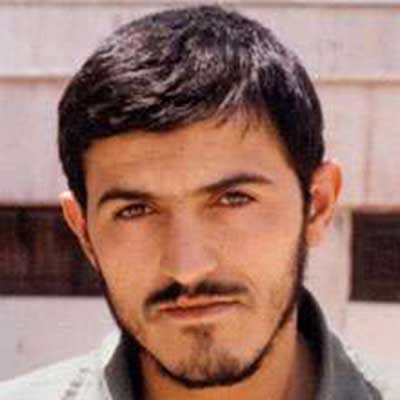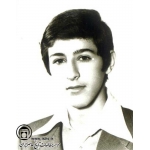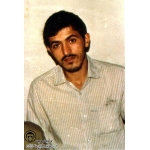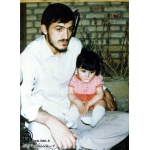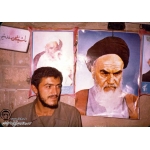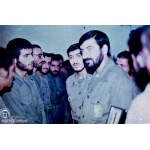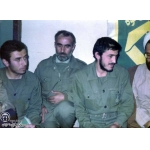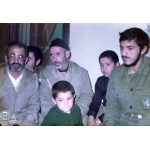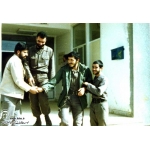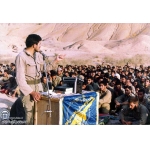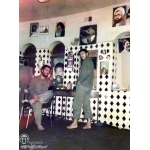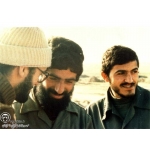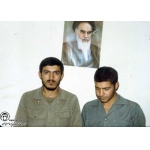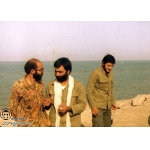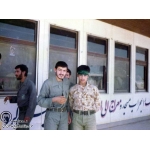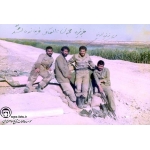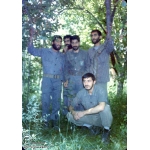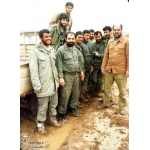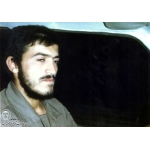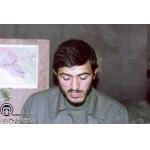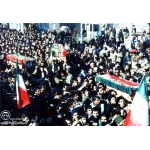Zeinoddin, Mahdi
Zahra Sadat Zouqi
444 بازدید
Zeinoddin, Mahdi
Written by: Zahra Sadat Zouqi
Mahdi Zeinoddin (1959–1984) was the commander of the 17th Ali ibn Abi Talib (as) Division of the Islamic Revolutionary Guard Corps (IRGC) during the Iran-Iraq War. He was martyred near Sardasht in West Azerbaijan Province.
Mahdi Zeinoddin was born in Tehran on October 11, 1959.[1] When he was five years old, his family moved to Khorramabad.[2] He was expelled from high school for refusing to join the Rastakhiz Party, which Muhammad Reza Pahlavi had declared mandatory for all citizens.[3] In 1977, he earned a diploma in natural sciences, after which he passed the university entrance exam and was admitted to Shiraz Medical University, ranking fourth. However, he withdrew from his studies when his father was exiled to Saqqez for supporting Imam Khomeini (RA).[4] His father owned a bookstore that sold anti-regime books and Imam Khomeini’s book on the practical laws of Islam. After his father’s exile, Mahdi took over the bookstore.[5]
In 1978, Mahdi was accepted to a university in France but chose to remain in Iran to pursue revolutionary activities.[6] A short time later, his father was exiled again, this time from Saqqez to Eqlid. As revolutionary activities intensified, Mahdi’s family secretly moved to Qom.[7]
After the establishment of the Jahad-e Sazandegi Organization in 1979, Zeinoddin joined and later became a member of the IRGC. He initially worked in the admissions department and later became head of the intelligence unit in Qom. In early 1980, Zeinoddin and 36 members of the Qom IRGC were sent to Sanandaj to counter anti-revolutionary insurgencies. Surrounded for three days, they eventually succeeded in liberating the city.[8]
Following the outbreak of the Iran-Iraq War on September 22, 1980, Zeinoddin underwent brief military training in Qom before heading to Khuzestan with a group of 100 people. He soon became the mission director of intelligence for the IRGC in Dezful and Susangerd, where he remained for eight months, participating in Operation Imam Mahdi (as), a joint effort between the IRGC and the Army on March 17, 1981. Zeinoddin later moved to Dezful, where he contributed significantly to reconnaissance efforts for various military operations.[9]
Before Operation Thamen al-Aemeh (as), conducted on September 27, 1981, which broke the siege of Abadan, Zeinoddin worked in the intelligence and operations department at Karbala Headquarters. He continued in this role until Operation Tariq al-Quds on November 29, 1981.[10]
At the Shush-Daniyal front, Iranian forces under the command of Majid Baqaei were divided into two parts, with one part joining the 17th Qom Brigade. In 1982,[11] at the age of 23, Mahdi married Monireh Armaghan,[12] and three months later, they moved to Ahvaz. They later had a daughter, Leyla.[13]
On July 24, 1982, Zeinoddin was appointed commander of the 17th Qom Brigade, which was later renamed the 17th Ali ibn Abi Talib (as) Brigade. His first mission as commander was during the fifth phase of Operation Ramadan.[14]
During Operation Muharram (November 1, 1982), the 17th Ali ibn Abi Talib (as) Brigade, under Zeinoddin’s leadership, was tasked with conducting reconnaissance in the Dehloran region. Following successful reconnaissance, the cities of Musian and Dehloran were liberated, and Zubeidat, a city in Iraq, was captured by Iranian forces. After the operation, the brigade was upgraded to the 17th Ali ibn Abi Talib (as) Division.[15]
As division commander, Zeinoddin participated in several major operations, including the Preliminary Valfajr (February 6, 1983), Valfajr 3 (July 29, 1983), Valfajr 4 (October 19, 1983), and Operation Kheibar (February 22, 1984). In 1983,[16] Zeinoddin, his wife,[17] and Gholam Ali Rashid, head of operations at the Khatam al-Anbiya (pbuh) Headquarters, traveled to Syria to train Hezbollah forces.[18]
On November 17, 1984, Mahdi Zeinoddin and his brother Majid, who headed intelligence and operations for the second brigade of the 17th Ali ibn Abi Talib (as) Division, were traveling from Kermanshah to Sardasht when they were ambushed by anti-revolutionary forces and martyred. Both were buried in the fifth sector of the Gulzar-e Shuhada Cemetery in Qom, next to Imamzadeh Ali ibn Jafar (as).[19]
A few days after their martyrdom, on November 27, 1984, Ayatollah Khamenei, then President of Iran, sent a message to Esmaeil Sadeqi, who succeeded Zeinoddin, praising his contributions and sacrifices.[20]
On September 27, 1989, during the sixth anniversary of Sacred Defense Week, Ayatollah Khamenei awarded the second-degree Fath medal to several military commanders, including Zeinoddin.[21]
Various places have been named in his honor, including the Martyr Zeinoddin Engineering Headquarters in Ahvaz, the Tank and Personnel Carrier Refurbishment Center in Isfahan, an educational complex in Qom, and the Martyr Zeinoddin Highway in Tehran.[22] A memorial has also been established in Sardasht, where Mahdi Zeinoddin was martyred.[23]
[1] Shahed Yaran, No. 100, February 2013, p. 4.
[2] Hojjati, Hamed, Shahidistan 1 (Memories and Relics of Martyr Mahdi Zeyn al-Din), Qom: Foundation for the Preservation and Dissemination of the Values of Sacred Defense of Qom, 2005, p. 26; Shahed Yaran, p. 64.
[3] Yavarmohammadi, Ahmad, Hekayati Digar As Tarikhcheh Ta Kongreh (Another Story from History to Congress), History and Record of Activities of the 17th Division of Ali ibn Abi Talib (AS), Qom: Secretariat of the Congress Commemorating the Martyr Mahdi Zein al-Din Guards, 1994, p. 22; Saremi Shahab, Asghar, The Iranian Nation's Resurrection Party, vol. 1, Tehran: Islamic Revolution Documents Center, 2006, p. 43.
[4] Yavarmohammadi, Ahmad, Hekayati Digar As Tarikhcheh Ta Kongreh, P. 21. Shaed Yaran, P. 67.
[5] Shaed Yaran, P. 68.
[6] Yavarmohammadi, Ahmad, Hekayati Digar As Tarikhcheh Ta Kongreh, P. 21. Shaed Yaran, P. 67.
[7] Hojjati, Hamed, Shahidistan 1 (Memories and Relics of Martyr Mahdi Zeyn al-Din), pp. 9 and 10, Shaed Yaran, P. 6.
[8] The Propaganda Unit of the Ali ibn Abi Talib (AS) Army and the Central District Headquarters, Ramze Movaffaghiat Dar Farmandehi (The Secret of Success in Command), Memoir of General Rashid of the Islamic Revolution Guards Corps, Martyr Mahdi Zein al-Din), Unplaced: The Islamic Revolutionary Guard Corps, 1985, p. 67; Shahid Yaran, p. 6; Encyclopedia of the Islamic Revolution, Vol. 2, Tehran: Surah Mehr, 1990, p. 52; Sadeghi, Reza, Guide Atlas, 9: Kurdistan Dar Jang Zedde Shoresh Va Defae Moqddas (Kurdistan in the Counter-Insurgency War and Sacred Defense), Tehran: Sacred Defense Documents and Research Center, 1993, p. 44.
[9] Shahed Yaran, pp. 6, 7, and 74; Rashid, Mohsen, Atlas of the Iran-Iraq War: A Concise Atlas of Land Battles (September 22, 1970 - August 20, 1988), Tehran: Center for War Studies and Research, p. 29.
[10] Shahed Yaran, p. 7; Rashid, Mohsen, Atlas of the Iran-Iraq War, pp. 46 and 47.
[11] Najimi, Mahmoud, Sizdah Dar Haft (Thirteen in Seven), Tehran: Sourah Mehr, 2015, p. 109; Rashid, Mohsen, Atlas of the Iran-Iraq War, pp. 48 and 49.
[12] Vaezi, Babak, Nimeh Penhan 5 (The Hidden Half 5: Zein al-Din as narrated by the Martyr's Wife, Tehran: Revayah Fath, 2003, pp. 9 and 20.)
[13] Shahed Yaran, p. 8.
[14] Ibid., pp. 8-10.
[15] Ibid., pp. 7 and 8; Rashid, Mohsen, Atlas of the Iran-Iraq War, pp. 68 and 69; Yarmohammadi, Ahmad, Hekayati Digar As Tarikhcheh Ta Kongreh, p. 12.
[16] Ramze Movaffaghiat Dar Farmandehi, p. 69; Rashid, Mohsen, Atlas of the Iran-Iraq War, pp. 59, 70, 72, and 90.
[17] Shahed Yaran, p. 19; Lotfollahzadegan, Alireza, Hemmati, Iraj, Iran-Iraq War Calendar, Book Twenty-Eight: The First Major Operation Northwest of Fajr 4, Tehran: Sacred Defense Documentation and Research Center of the Islamic Revolutionary Guard Corps, 2017, p. 73
[18] Vaezi, Babak, Nimeh Penhan 5, pp. 9, 20, and 28.
[19] Shahed Yaran, pp. 12, 13, and 90; Jomhoori Eslami Newspaper, No. 1590, November 24, 1989, p. 4.
[20] Shahed Yaran, p. 2.
[21] Jomhoori Eslami Newspaper, No. 2993, September 28, 1989, p. 12.
[22] Shahed Yaran, p. 12; Keyhan Newspaper, No. 21494, November 21, 2016, p. 3.
[23] Najafi, Hossein, Sal Haye Mandegar (Lasting Years, Tabriz): Foundation for the Preservation of Works and Publication of the Values of the Sacred Defense of East Azerbaijan, 2005, p. 186.


